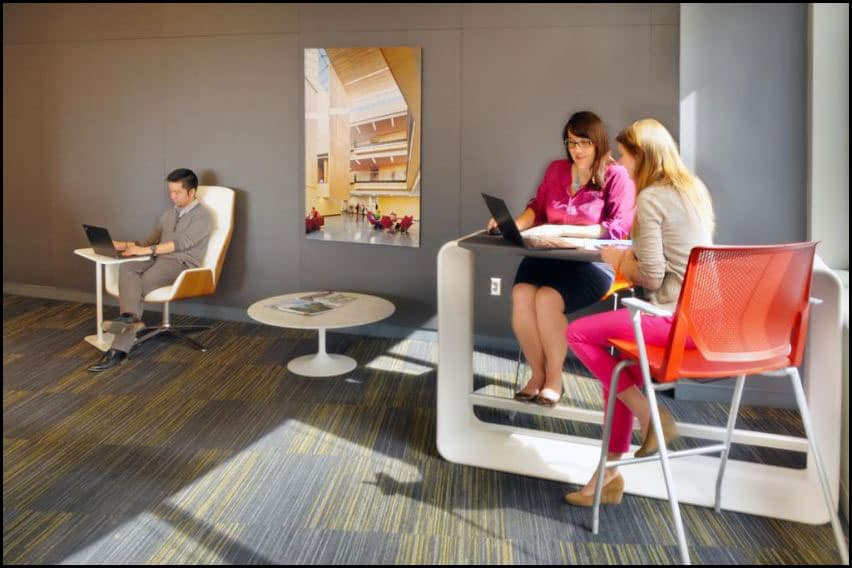You see them perched on high-top tables, lounging in comfy chairs, or gravitating to the sunlight filtering in through office windows. You also see them working. They are mobile workers, and they are today’s office workforce.
Thanks to improved Wi-Fi availability and better, lighter laptops, today’s professional worker is no longer tethered to a desk by an Ethernet cable and desktop computer.
1. Your open office looks like a ghost town
Today’s workplace is all about collaboration, and workers spend a great deal of time in meeting rooms. Add the time spent out of the offices, and you get
a bunch of unoccupied desks. If one workstation is empty 40 percent of the time, this is estimated to cost a company $7,735 a year. If nobody is at their desks, they may be already mobile.
2. Your conference rooms are always booked
Industry trends show that workers’ personal space continues to shrink. But this doesn’t always mean a smaller overall office. By reducing individually owned “me” spaces and adding more shared “we” spaces through mobile work strategies, companies can better utilize both physical and intellectual resources.
3. You’re out of space
If your office is growing, but you’re not ready to make the financial investment to acquire more space, non-assigned workspaces can be a solution. The workstations take up less space as mobile workers purge personal items, and shared workspaces result in fewer overall seats. Non-traditional workspaces such as worktables, booths and lounge areas also become part of the solution.
4. You need to recruit
Today’s graduates are accustomed to working mobile and they expect to have access to mobile devices when collaborating. Workers of all ages like to be able to select from a variety of settings based on task, stimulation level and preference. Unless you are going to customize everyone’s workspace, mobility allows workers to pick the right setting.
5. Your star employee is moving
As the economy heats up, the pressure to find and keep talent is increasing. Allowing staff flexibility to work remotely can allow you to keep some of the best talent.
6. Everyone is wearing headphones
Do staff wear headphones to get their work done? Whether this is an actual noise problem or just a polite way to tell your coworkers to stop talking to you, it likely means your workstations aren’t allowing for focused work. Providing quiet areas and even quiet rooms allow workers to choose the desired amount of stimulation.
7. You’re investing in technology
So you aren’t really thinking about going mobile, but you need to upgrade your phone system, computers, printers and copiers, AV or wireless systems. Many of these solutions are inherently designed for mobility and can help you operate your business more efficiently. Once the technology is in place, it’s easy to go mobile.
8. Your desk is a mess
Mobile workers learn quickly that they don’t want to carry around a lot of stuff. They need to develop digital intake and output processes, and maintain an easy-to-use digital filing system. While doubtful anyone goes completely paperless, successful mobile workers can quickly access files from anywhere.
9. Everyone is asleep at their desks
Prolonged sitting causes all bodily functions to slow down, including the brain. Different areas within the office for standing work, and even a treadmill desk, allow people to move and get the blood pumping without the cost of providing an adjustable-height desk for every employee.
10. You want staff to come to the office
Mobility doesn’t have to mean remotely. One of the reasons that companies like Google are so successful with their mobile programs is that people still come to the office. By enabling mobility within the office, companies still benefit from the face-to-face interactions that encourage collaboration, trust-building and culture, and give workers the flexibility to work anywhere.
11. You are open to a pilot program
There is no single perfect mobile workplace formula, and finding the right program can take some refinement. Pilot programs allow companies to explore new ways of working within a lens of experimentation. It allows for adjustments and even some failures without expending a great deal of money.
12. You want to get it right
Lastly, to make mobile work a success, you have to have the right employee, the right job, the right technology, and the right processes in place. Mobile work isn’t for everyone. Companies with successful programs fit the opportunity to the individual rather than forcing all individuals into the fit.
 This article is by Jennifer Stukenberg and first appeared in the The Business Journals on 21st Apr 2015.
This article is by Jennifer Stukenberg and first appeared in the The Business Journals on 21st Apr 2015.

